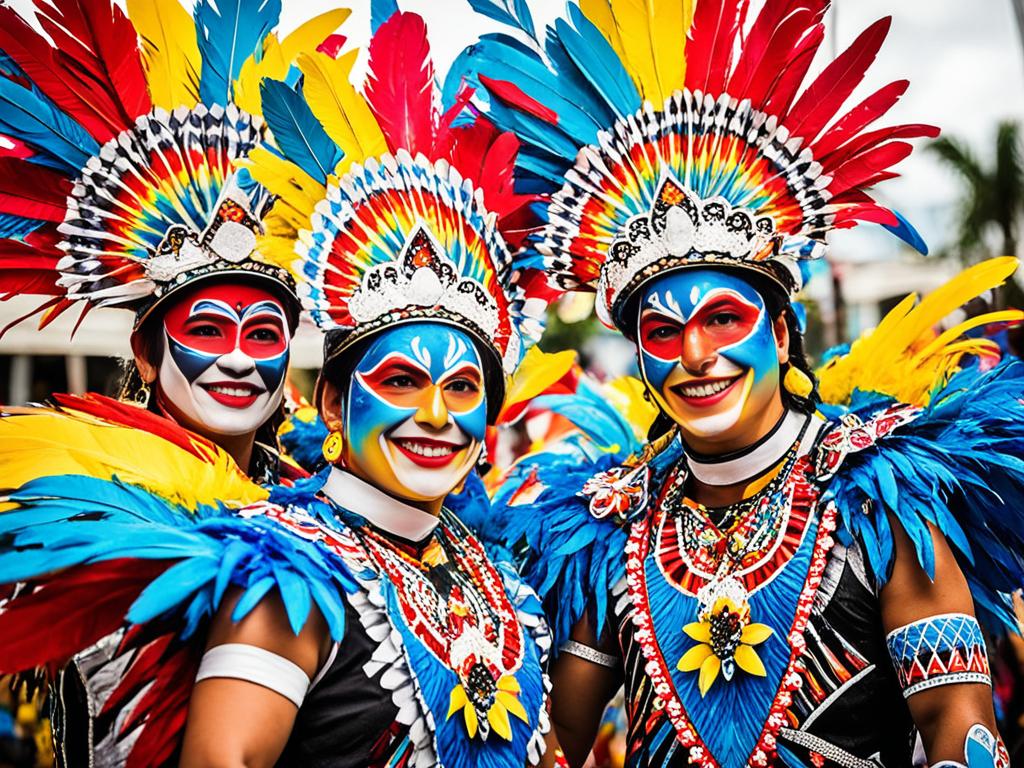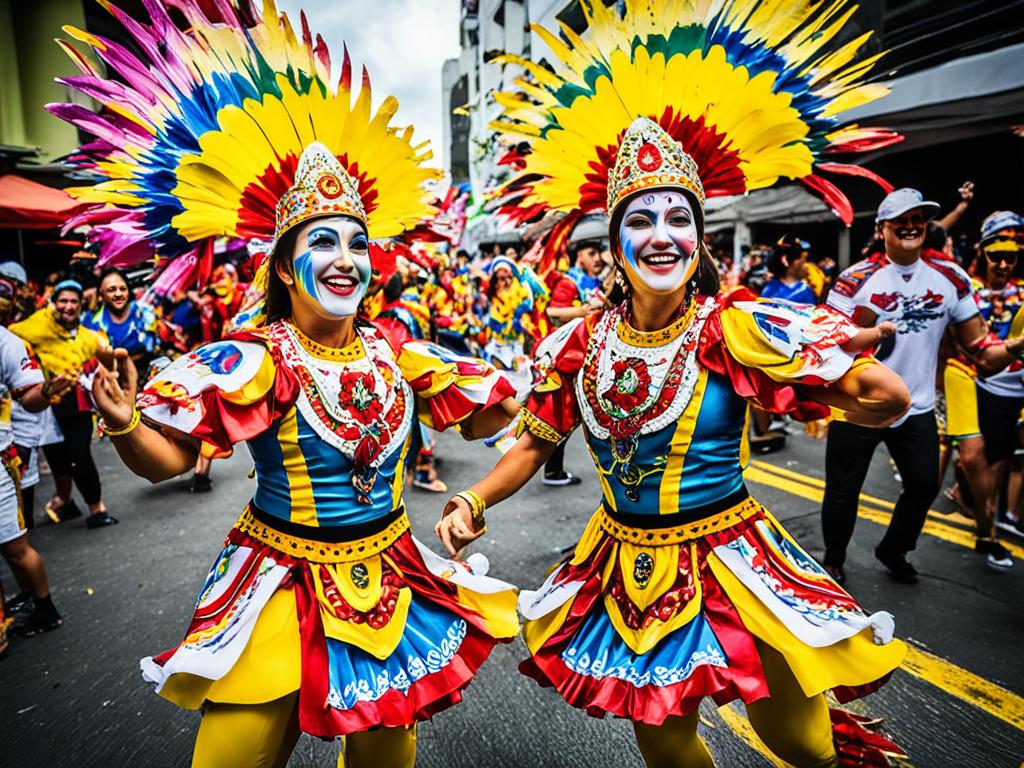Picture a busy street full of people in bright clothes. Their faces are painted with vivid colors. You hear the beat of music in the background. This is the Ati-Atihan Festival in the Philippines. It’s a celebration in Aklan that honors Santo Niño, the young Jesus. The event shows off the Aklanon people’s deep cultural roots and traditions.
During the festival, the streets come alive. People change into colorful outfits and paint their faces. They wear special costumes that tell stories. Each outfit is a masterpiece. You can see bright feathers, detailed designs, and special body decorations. Everything together is truly amazing to see.
The Ati-Atihan Festival means more than just celebrating Santo Niño. It’s about coming together to be happy and proud of Aklanon culture. This celebration has been around for hundreds of years. It’s a time for everyone, no matter where they’re from, to join in the fun. They dance and enjoy the lively vibe of the festival.
Key Takeaways:
- The Ati-Atihan Festival is a vibrant celebration held in Aklan, Philippines, to honor Santo Niño.
- Participants paint their faces and dress in colorful tribal costumes, creating a visual spectacle.
- The festival is deeply rooted in the indigenous culture of the Aklanon people, showcasing their rich heritage.
- It is a time of unity, joy, and pride, where locals and visitors come together to celebrate and dance.
- The Ati-Atihan Festival is a must-see cultural event, attracting tourists from around the world.
The History of Ati-Atihan Festival
The Ati-Atihan Festival began in the 13th century with Malay settlers in the Kalibo area of Aklan. As the legend goes, the locals welcomed the newcomers by wearing dark skin and their traditional clothes. This act started a festival to celebrate their unity and diversity. Over time, this celebration changed with the arrival of the Spanish.
With Spanish influence came Catholicism, impacting the Ati-Atihan Festival’s traditions. Today, the festival combines both native and Spanish cultures. It stands as a unique event in the region, showcasing the diverse history and culture of Aklan.
Centuries later, the Ati-Atihan Festival still celebrates cultural harmony. It shows how different cultural elements can live together well. This festival is a clear sign of the Aklanon people’s strength and openness to new influences, while keeping their traditions alive.
The Ati-Atihan Festival is a remarkable example of the fusion of cultures and the resilience of indigenous traditions in the face of colonial influences. It serves as a reminder of the significance and power of cultural celebrations in preserving and promoting heritage.
Rituals and Traditions of Ati-Atihan Festival
The Ati-Atihan Festival is a big part of the Aklanon people’s culture. It includes many rituals and traditions. These make the celebration both spiritual and fun.
The festival starts with a novena. This is nine days of prayer before the main events. During the novena, people go to church to pray and ask for blessings from Santo Niño.
On the festival day, a serious procession happens. This procession means a lot to the celebration. It involves moving the Santo Niño image through the streets. People in colorful clothes walk with it, showing their love and worship.
After the procession, the festival turns into a vibrant show. With street parades and tribal dances, it becomes lively. The beats of traditional music fill the streets. Everyone dances energetically in their bright costumes.
Tribal dances are a highlight, showing the Aklanon people’s heritage. These dances are from old times and hold a strong cultural value. They tell stories and showcase the community’s beliefs and history.
“The Ati-Atihan Festival mixes religious devotion with cultural joy. The unique rituals and traditions bring everyone together. They honor Santo Niño and show the deep heritage of the Aklanon people.”
The mix of religious rites, procession, parades, and dances creates a thrilling scene. It engages both those taking part and those watching. This festival unites the Aklanons in their faith and cultural pride, celebrating with much enthusiasm.
Come and see the amazing rituals and traditions of the Ati-Atihan Festival!
| Rituals and Traditions | Details |
|---|---|
| Novena | A nine-day period of prayer and devotion leading up to the festival. |
| Procession | A solemn procession carrying the image of Santo Niño. |
| Street Parades | Colorful parades with participants showcasing vibrant costumes. |
| Tribal Dances | Energetic dances representing the indigenous culture and traditions. |
Colorful Costumes and Face Paintings
The Ati-Atihan Festival is known for its bright and lavish outfits. These clothes show off the Aklanon culture with their vivid colors and special designs. They often include feathers and beads.
The traditional costumes are made with great care. They use vibrant colors to make the festival lively and beautiful. People wear these to honor their heritage during the event.
Another big part of the festival is face paintings. People paint their faces in bright colors, like the Ati masks. This isn’t just for looks. It also honors the Ati people, who greatly influenced Aklan’s culture.

At the festival, every street is full of colors and people wearing special accessories. Feathers and beads decorate the outfits, making everything look more magical. This decoration is also a sign of Aklan’s history and culture.
“The elaborate costumes and face paintings are a testament to the Aklanon people’s dedication in preserving and showcasing their cultural roots. The vibrant colors and traditional body adornments create an enchanting ambiance, captivating both locals and visitors alike during the Ati-Atihan Festival.”
Economic Impact and Philippine Tourism
The Ati-Atihan Festival is a big deal for not just celebrating culture but boosting the local economy and Philippines too. It brings a ton of tourists, from near and far, who spend money on various things. This helps the area make more money from tourism.
The festival boosts business for the locals by increasing sales. It’s a chance for shops to show off what they have and earn more. Everywhere from food to souvenirs sees a rise in demand.
This event is more than just a local boost. It also helps bring in more people interested in the country’s culture. Its unique activities and colorful vibe attract visitors wanting to see the true Filipino spirit.
People from other countries love the festival for its authentic cultural experience. It guides them to explore more of the country’s cultural spots. This growth in cultural tourism helps increase tourism all over the Philippines.
The festival’s good effects last longer than its days. It turns the area into a hot spot for tourism year-round. This ongoing attention means more work and money for the local folks.
The Ati-Atihan Festival is key for the Philippines’ growth. It supports local shops, makes more tourism money, and pushes cultural tourism. With its lively events and deep cultural roots, it stays a must-see event in the Philippines.
Economic Impact of the Ati-Atihan Festival
| Aspect | Impact |
|---|---|
| Tourism Revenue | Significant increase during the festival period due to domestic and international visitors. |
| Local Business Sales | Thriving local businesses with increased sales of food, beverages, handicrafts, and souvenirs. |
| Cultural Tourism | Promotes cultural tourism in the region, attracting visitors interested in unique traditions. |
| International Visitors | Enhances the cultural appeal of the Philippines, attracting and engaging international tourists. |
| Year-round Impact | Promotes the region as a tourist destination beyond the festival period, ensuring sustained economic activity. |
Conclusion
The Philippines – Ati-Atihan Festival is a lively celebration that honors Santo Niño. It beautifully shows the Aklanon people’s culture. It features bright costumes, lively dances, and interesting rituals. Anyone from participants to visitors can enjoy this unique event.
The Ati-Atihan Festival shows the Philippines’ rich native culture mixed with Spanish influences. It is seen in the colorful costumes, ancient practices, and energetic dances. This fusion makes the festival stand out.
The Ati-Atihan Festival has been loved for centuries. It draws people worldwide to see its bold spirit. This event honors Santo Niño and shows the Aklanon’s strength and pride every year.
Joining the Ati-Atihan Festival means becoming part of a vibrant celebration. You can enjoy the deep cultural roots, traditional rituals, or the fun of the street parades. It’s a chance to celebrate with the Aklanon people and experience a memorable part of Philippine culture.




